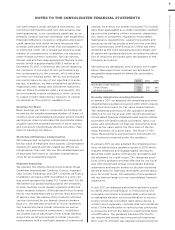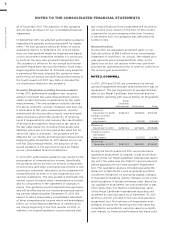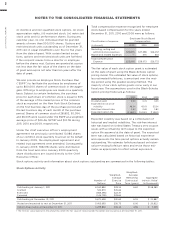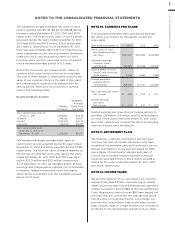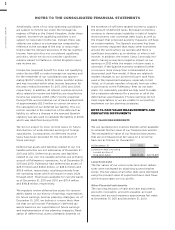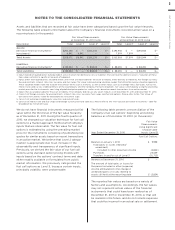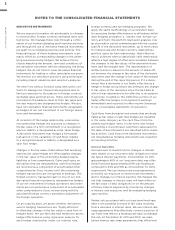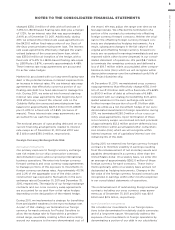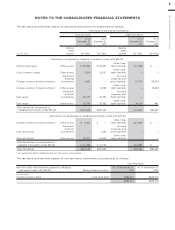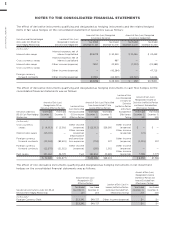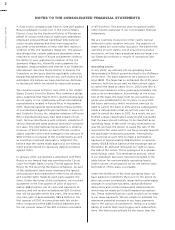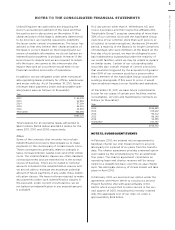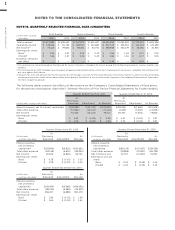Royal Caribbean Cruise Lines 2011 Annual Report Download - page 88
Download and view the complete annual report
Please find page 88 of the 2011 Royal Caribbean Cruise Lines annual report below. You can navigate through the pages in the report by either clicking on the pages listed below, or by using the keyword search tool below to find specific information within the annual report.
2011 ANNUAL REPORT 84
NOTES TO THE CONSOLIDATED FINANCIAL STATEMENTS
Additionally, some of our ship-operating subsidiaries
are subject to income tax under the tonnage tax
regimes of Malta or the United Kingdom. Under these
regimes, income from qualifying activities is not
subject to corporate income tax. Instead, these sub-
sidiaries are subject to a tonnage tax computed by
reference to the tonnage of the ship or ships regis-
tered under the relevant provisions of the tax regimes.
Income from activities not considered qualifying
activities, which we do not consider significant,
remains subject to Maltese or United Kingdom corpo-
rate income tax.
Income tax (expense) benefit for items not qualifying
under Section 883 or under tonnage tax regimes and
for the remainder of our subsidiaries was approxi-
mately $(20.7) million, $(20.3) million and $5.1 million
and was recorded within other income (expense) for
the years ended December 31, 2011, 2010 and 2009,
respectively. In addition, all interest expense and pen-
alties related to income tax liabilities are classified as
income tax expense within other income (expense).
During 2009, we recorded an out of period adjustment
of approximately $12.3 million to correct an error in
the calculation of our deferred tax liability. This cor-
rection resulted in the reduction of the deferred tax
liability to reflect a change in the enacted Spanish
statutory tax rate used to calculate the liability in 2006
which was identified during 2009.
We do not expect to incur income taxes on future
distributions of undistributed earnings of foreign
subsidiaries. Consequently, no deferred income
taxes have been provided for the distribution of
these earnings.
Deferred tax assets and liabilities related to our U.S.
taxable activities are not material as of December 31,
2011 and 2010. Deferred tax assets and liabilities
related to our non-U.S. taxable activities are primarily
a result of Pullmantur’s operations. As of December 31,
2011 and 2010, Pullmantur had deferred tax assets of
€25.9 million and €26.6 million, or $33.6 million and
$35.6 million, respectively, resulting primarily from
net operating losses which will expire in years 2024
through 2027. Total losses available for carryforwards
as of December 31, 2011 and 2010 are $111.4 million
and $118.8 million, respectively.
We regularly review deferred tax assets for recover-
ability based on our history of earnings, expectations
for future earnings, and tax planning strategies. As of
December 31, 2011, we believe it is more likely than
not that we will recover Pullmantur’s deferred tax
assets based on our expectation of future earnings
and implementation of tax planning strategies. Reali-
zation of deferred tax assets ultimately depends on
the existence of sufficient taxable income to support
the amount of deferred taxes. European economies
continue to demonstrate instability in light of height-
ened concerns over sovereign debt issues as well as
the impact that proposed austerity measures will have
on certain markets. The Spanish economy has been
more severely impacted than many other economies
around the world where we operate and there is
significant uncertainty as to whether or when it will
recover. In addition, the recent Costa Concordia inci-
dent is having a near-term negative impact on our
earnings in 2012 while the impact in future years is
uncertain. If the Spanish economy weakens further
or recovers more slowly than contemplated in our
discounted cash flow model, if there are relatively
modest changes to our projected future cash flows
used in the impairment analyses, especially in Net
Yields, or if certain transfers of vessels from our other
cruise brands to the Pullmantur fleet do not take
place, it is reasonably possible we may need to estab-
lish a valuation allowance for a portion or all of the
deferred tax asset balance if future earnings do not
meet expectations or we are unable to successfully
implement our tax planning strategies.
NOTE 13. FAIR VALUE MEASUREMENTS AND
DERIVATIVE INSTRUMENTS
FAIR VALUE MEASUREMENTS
We use quoted prices in active markets when available
to estimate the fair value of our financial instruments.
The estimated fair value of our financial instruments
that are not measured at fair value on a recurring
basis are as follows (in thousands):
At December 31,
Long-term debt (including
current portion of
long-term debt)
Long-Term Debt
The fair values of our senior notes and senior deben-
tures were estimated by obtaining quoted market
prices. The fair values of all other debt were estimated
using the present value of expected future cash flows
which incorporates our risk profile.
Other Financial Instruments
The carrying amounts of cash and cash equivalents,
accounts receivable, accounts payable, accrued
interest and accrued expenses approximate fair value
at December 31, 2011 and December 31, 2010.



